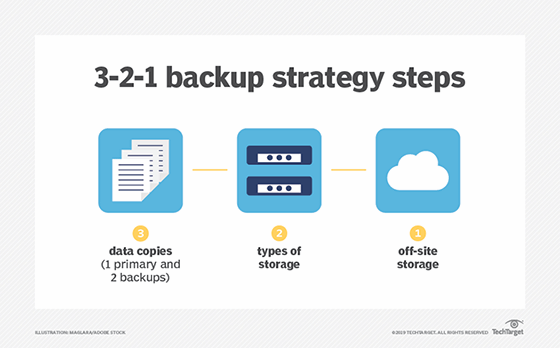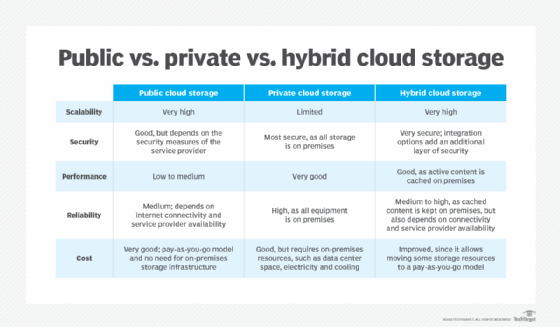
backup storage device
What is a backup storage device?
A backup storage device is a hardware component for storing copies of data. The data originates from one or more other storage devices, which might be embedded in servers, desktop PCs or other systems. Backup storage devices are typically used to provide redundancy for data residing on primary storage, such as the type used to support mission-critical transactional applications. Various types of storage media are used for backup devices, including solid-state drives (SSDs), hard disk drives (HDDs), optical drives and magnetic tape systems.
Many consumers use backup storage devices to protect their personal data, as do most organizations. The use of backup storage is imperative in enterprise settings, where any type of data loss can be potentially catastrophic. If the data on a primary storage device becomes unavailable for any reason, such as a drive failure or malware attack, the data can often be recovered from copies on the backup hardware.
Organizations use backup storage devices to store redundant copies of data that they consider critical to sustaining business operations. Such devices include dedicated purpose-built backup appliances and magnetic tape systems. An organization might back up its database files, user and application data, source code files, configuration files, log data, customer data or other types of data.
A growing number of organizations are also backing up data from their edge computing environments, either copying the data to the cloud or to a centralized data center. In addition, many organizations back up data from their virtual machines (VMs), both virtual servers and virtual desktops. To facilitate this process, a backup client might be installed in each VM, which then copies the data to the target backup storage system.

What types of storage devices are used for backing up data?
A backup storage device might be an SSD, HDD, optical disk or tape system. The type of medium used depends in part on how quickly the data needs to be restored if something should happen to the primary storage. Write performance can also play a role, depending on the frequency of the backups and amount of data. Available budget is another consideration when choosing a backup system. For example, tape storage is much cheaper than HDD storage, but it takes far longer to read data from tape than from an HDD.
Organizations might combine media types to strike a balance between performance and budget. For example, some IT teams store their backup data on HDD-based storage systems. However, the systems are also configured with flash cache, which can improve both read and write performance. In this way, they get a boost in performance without needing to invest in all-flash arrays.
Magnetic tape is one of the oldest backup storage device technologies, but its use is now often limited to data archiving, rather than storing backups. Although a tape system offers high durability and capacity at a relatively lower cost, the system writes and reads data linearly and does not support random access. As a result, the data cannot be retrieved as quickly as other storage media. A tape system is designed for long-term storage, not for quick retrieval.
Despite this trend, some organizations continue to use tape systems as part of their backup strategies because it's more cost-effective than disk-based alternatives. Tape systems have also been made more viable as a result of advances in tape formatting systems, such as the Linear Tape Open standard, an open format compatible with multiple storage products.
Organizations use tape systems as part of their backup strategies for a variety of reasons:
- They've evaluated their workloads, types of data and other aspects of their circumstances and determined that the benefits of tape systems outweigh the challenges.
- Their backup strategies follow the 3-2-1 backup strategy, which states that you should maintain at least three copies of your data, using two different types of media, with one copy kept off-site.
- They use a disk-to-disk-to-tape backup strategy in which the primary data is initially copied to a disk-based backup storage system and then periodically written from the backup disks to the tape system. In that scenario, organizations can recover their data quickly when needed from the disk system but still get the added protections that come from the tape system, especially if the tapes are stored off-site.

Most disk-based backup storage appliances support the ability to copy data to magnetic tape storage, whether it's done as part of a backup strategy or as a way to archive the data for long-term retention.
It's also possible to use optical disks, such as Blu-ray discs, compact discs and digital video discs, for storing backup data. Optical disks are much more durable than the other media types, and they're relatively inexpensive to manufacture. That said, optical disks are slower than HDDs and SSDs -- impacting how quickly backups can be created and restored -- and they provide much lower data capacities. For these reasons, enterprise backup technology based on optical storage devices has lagged in the marketplace compared with other storage media.
Some backup storage systems support the use of removable media, such as cartridges, optical discs or USB drives. Removable media can make it easier to copy data from one computer to another. Although this can facilitate faster recovery times, the portability also creates potential security risks. In addition, removable media is usually more expensive than fixed storage systems.
People who work in the field might also use portable storage devices to back up their data to ensure that their work doesn't get lost, in case something should happen to their devices before they can connect to a reliable and secure network. Devices that can connect to the internet while in the field generally don't have this problem because they can access a cloud platform or private network directly. However, such connectivity is not always an option, or security concerns might call for different measures.
Enterprise backup strategies
Many primary storage systems include native capabilities that facilitate disaster recovery (DR). For example, a primary storage system might support redundant array of independent disks, replication or the use of snapshots. However, a full-fledged backup system is typically implemented separately from the built-in functionality. The backup systems might use similar technology, such as generating snapshots, but the system still remains separate from the primary storage.
Most organizations implement some type of backup application to help safeguard their data. A backup app manages the backup process, includes built-in data protections and defends the data from events such as natural disasters or cyberattacks. The backup storage devices might be integrated directly within these systems, as in the case of appliances, or the devices might be located separately, sometimes in different locations.
Enterprise backup systems take different approaches to protecting data. One common strategy is to create a centralized backup system for multiple enterprise systems, such as desktops, servers, VMs or network-attached storage (NAS). In this arrangement, each system is configured with a backup client that transmits copies of the system's data to a centralized backup server or server cluster.
The backup server runs backup management software that directs the data to specific backup storage devices, either on premises or in the cloud. The data might be transmitted over the corporate intranet, a secure high-bandwidth network connection or even the internet. The server connects to the storage devices through the use of standard protocols, such as Network File System or Internet Small Computer System Interface.
Some organizations, especially small to midsize ones, might rely on NAS storage devices for their backup requirements. A NAS system provides a centralized file storage environment that workstations and servers can easily connect to over an Ethernet network. Many NAS systems also support connectivity over wide area networks and virtual private networks.
A variant of physical NAS hardware is cloud NAS, which is commonly deployed for archive and backup data. Cloud NAS provides remote backup services that operate in much the same way as on-premises NAS. With cloud NAS, data is accessible from any location and at any time, although access speed depends on the network's data transfer rate.
Larger organizations that implement storage area networks often incorporate backup storage devices into their SAN environments. A SAN consists of a dedicated high-speed network that interconnects shared pools of storage devices and presents them to multiple servers. Data is typically stored at the block level, using software to keep track of the data blocks that have changed since the last full backup. This process, known as changed block tracking, sends only the changed blocks to the backup storage.
Some organizations deploy virtual tape libraries (VTLs) for their backups. A VTL is a backup storage device that mimics the behavior of a physical tape system. Compared with a NAS device, a VTL provides better efficiency and performance to organizations running Fibre Channel networked storage. VTLs offer integrated data deduplication and write directly to disk. Backup and recovery operations are faster than some backup methods, and the operating costs are lower.
Regardless of how a backup strategy is implemented or the type of storage devices used, organizations must take the steps necessary to protect those devices against cyberattacks and malware, such as ransomware, spyware or Trojans. They should also safeguard the devices and their data from indirect attacks. For example, a worm might infiltrate the network through a user's email and ultimately work its way to the backup storage. As long as the backup data is properly protected, it can be used to quickly replace the primary data if it should become corrupted or compromised for any reason.

Backup appliances
Many organizations deploy hardware appliances to support their backup strategies. An appliance contains its own storage media and is bundled with data protection management software. These systems are sometimes referred to as integrated backup storage appliances.
Backup appliances are designed to simplify data protection and DR processes and usually include features such as data deduplication, data compression, encryption and backup software integration. They also provide automated features to help monitor disk capacity, expand storage capacity and manage preconfigured tape libraries.
A remote backup appliance works similarly to a local backup appliance. Data is copied to the device over the internet and is typically accessed through an HTTPS connection or web browser, although USB ports can also be used to load data directly to the remote appliance. Remote backup appliances can play an important role in an enterprise DR plan and help ensure business continuity (BC).
Cloud backup storage: Public, private and hybrid
Some cloud service providers offer backup services that manage the backup processes and store data in the cloud. Customers pay a subscription fee that is based on factors such as bandwidth usage, storage capacity or number of users. Cloud backup services can help simplify backup processes, while providing scalable capacity. However, subscription fees can quickly add up. Organizations should carefully calculate the total cost of ownership before assuming that a cloud service is the most economical approach to data backup.
Cloud-to-cloud backup is an offshoot of the cloud backup service in which data is copied between public cloud storage platforms. Using cloud-to-cloud backup hastens the recovery of mission-critical data, although it also increases the chances that storage security could be compromised -- at least, in comparison to hard offline backup. In addition, the cost of these services needs to be taken into account.
Some enterprises host their own internal private clouds, which often include storage services. In this way, they can back up their data to locally managed servers, while having some of the flexibility that comes with public cloud platforms. Other organizations implement hybrid cloud environments that combine cloud storage with internal private storage.
Data that is copied to the cloud is often saved as object storage. Unlike file storage, data in object storage exists in a nonhierarchical format, with every object sharing the same flat address space. Each object also supports customizable metadata. Object storage is highly scalable and can handle large amounts of unstructured data, making it well suited for the types of data often found in today's organizations. Many on-premises systems, such as NAS and SAN, now provide object storage capabilities.

Backup storage devices for personal devices
Users on PCs and other devices often use portable backup storage devices to protect their data. For example, they might connect external disk drives or USB flash drives to their systems and use those for backup data. An external drive might be nothing more than a small SSD or HDD that attaches directly to the device.
A USB drive -- also known as a flash drive, thumb drive or keychain drive -- is a lightweight, portable storage device that uses flash memory storage. The computer's operating system recognizes it as a removable drive when it's inserted into a USB port.
Many people now use cloud services for backing up their data rather than relying on portable physical devices. Cloud vendors offer backup services for Windows, macOS, Android and iOS devices. The services provide home users and small businesses with multiple backup and security options, including ransomware protection, vulnerability scanning, cloud syncing, file sharing and network drive backups.
Backup storage serves a crucial role in both DR and BC. Delve into the realm of 10 emerging DR trends that IT teams should monitor closely.






